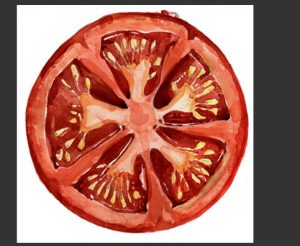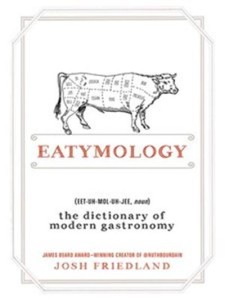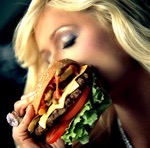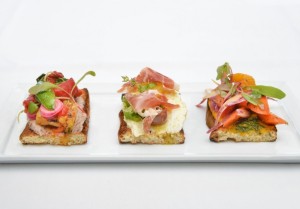I’ve long maintained that food safety gets about 1% of food discussion and food porn gets the other 99%.
This is from John Oliver’s show last Sunday and validates my assertions.
Warning, NSFV.

I’ve long maintained that food safety gets about 1% of food discussion and food porn gets the other 99%.
This is from John Oliver’s show last Sunday and validates my assertions.
Warning, NSFV.
Michael Pollan is an entertainer from a long line of American hucksters.
He’s not a professor, he’s a decent writer of food porn.
 (Those with the least qualifications most actively seek the perceived credibility of a title.)
(Those with the least qualifications most actively seek the perceived credibility of a title.)
When his biggest soundbite is “I’d never eat a refrigerated tomato,” the absolutism shines through like any other spoiled demagogue.
Dan Charles of NPR fell into the gotta-be-cool trap without knowing shit, but eventually admitted it.
Charles says, There’s a laboratory at the University of University of Florida, in Gainesville, that has been at the forefront of research on tomato taste. Scientists there have been studying the chemical makeup of great-tasting tomatoes, as well as the not-so-great tasting ones at supermarkets.
“There’s a lot of things wrong with tomatoes right now,” says Denise Tieman, a research associate professor there. “We’re trying to fix them, or at least figure out what’s going wrong.”
These researchers studied this refrigeration question. They looked at what happened when a tomato goes into your kitchen fridge, or into the tomato industry’s refrigerated trucks and storage rooms.
Some components of a tomato’s flavor were unaffected, such as sugars and acids. But they found that after seven days of refrigeration, tomatoes had lower levels of certain chemicals that Tieman says are really important. These so-called aroma compounds easily vaporize. “That’s what gives the tomato its distinctive aroma and flavor,” she says.
The researchers also gave chilled and unchilled tomatoes to dozens of people to evaluate, in blind taste tests, “and they could definitely tell the difference,” says Tieman. The tomatoes that weren’t chilled got better ratings.
The scientists also figured out how chilling reduced flavor; cold temperatures actually turned off specific genes, and that, in turn cut down production of these flavor compounds.
Tieman speculates that someday scientists will figure out how to keep those genes turned on, even when chilled, so the tomato industry can have it both ways: They can refrigerate tomatoes to extend shelf life, without losing flavor.
 Thankfully, chilling didn’t seem to affect nutrition – the chilled tomatoes were just as nutritious as the non-refrigerated ones.
Thankfully, chilling didn’t seem to affect nutrition – the chilled tomatoes were just as nutritious as the non-refrigerated ones.
The new findings appear in this week’s issue of the Proceedings of the National Academy of Sciences.
As significant as the results are, they probably won’t end the great tomato refrigeration debate.
“It’s not so clear cut,” says Daniel Gritzer, culinary director at SeriousEats.com, a food website. Two years ago, he did a series of blind taste tests with many different tomatoes, in New York and in California.
“Sometimes I found that the refrigerator is, in fact, your best bet,” says Gritzer.
That’s especially true for a tomato that’s already ripe and at peak flavor, he says. If you let that tomato sit on your counter, it’ll end up tasting worse.
Gritzer wrote a long blog post, detailing his results, and got a flood of reaction. “Some people wrote to say, ‘Hey, this is what I’ve always found, I’m so glad you wrote this,'” Gritzer says. “And then, a lot of people pushed back saying, ‘You’re insane, you don’t know what you’re talking about.'”
And when the hockey kids call me Doug, I say that’s Dr. Doug, I didn’t spend six years in evil hockey coaching land to be called Mister.
 Carl’s Jr has set up shop in Bateau Bay near The Entrance, next to McDonald’s, and is offering a year’s worth of free burgers to the first 50 people through the door on Tuesday.
Carl’s Jr has set up shop in Bateau Bay near The Entrance, next to McDonald’s, and is offering a year’s worth of free burgers to the first 50 people through the door on Tuesday.
It’s a publicity stunt set to rival that of fellow US burger chain In-N-Out, which opened a four-hour pop-up restaurant in Surry Hills last month and sold out of product half an hour before the store opened.
NPR reports the food-obsessed media landscape has proven fertile ground for word play. There are now new words to describe every food niche or gastronomical preference.
 Can’t stand little kids running amok in your favorite Korean fusion restaurant? You might havebratophobia. And you could be a gastrosexual if you use your cooking prowess to attract that new special someone.
Can’t stand little kids running amok in your favorite Korean fusion restaurant? You might havebratophobia. And you could be a gastrosexual if you use your cooking prowess to attract that new special someone.
In his new book Eatymology, humorist and food writer Josh Friedland has collected many of these neologisms in a 21st-century food dictionary.
Friedland recently spoke with NPR’s Rachel Martin, host of Weekend Edition Sunday. Highlights from their conversation are excerpted below.
On the ‘sourdough hotel’
“So this is in Stockholm. There is a place, a bakery, where, you know, if you are devoted to keeping your own sourdough starter and feeding it every day with flour, if you need to go on vacation, you can leave your sourdough with this bakery. They’ll keep it on a shelf and feed it daily for you while you’re gone. It’s like boarding for your pet.
On ‘brogurt‘ — yogurt marketed to men
The one that did it was this company Powerful Yogurt. It’s on store shelves now, and they target – you know, it’s like marketing, like, an energy drink for guys.
On ‘blood cashews’
“This was based on a Human Rights Watch report on the way cashews are processed in Vietnam, which is one of the world’s biggest exporters of cashews. So it turns out that in Vietnam, people who are convicted for drug offenses are sent to drug treatment centers where they are basically forced labor for producing cashews, for processing them and getting them ready for export. And, you know, it borrows from this idea of blood diamonds, obviously. So yeah, no, the book blends the hilarious and the ridiculous and the quite serious.”
In the summer of 2015, some 150 people were stricken with Salmonella at uppity Fig and Olive restaurants in Washington, D.C. and Los Angeles.
When you order truffle risotto at an upscale restaurant—the kind that lists local farms at the top of its menu—you might expect that the dish is prepared fresh, from-scratch in the kitchen. But at Fig & Olive, the $26 truffle risotto (no longer on the menu) was pre-cooked and frozen at a central commissary in Long Island City, New York, then shipped to restaurants around the country, where it was reheated with cheese and garnished.
In fact, the commissary supplies Fig & Olive restaurants with nearly 200 dish components, including soups, sauces, purees, dressings, desserts, breads, ratatouille, ravioli, crab cakes, pre-cooked chicken tagine, pre-cooked paella, and more.
Fig & Olive representatives declined to comment, but a Freedom of Information Act request to the D.C. Department of Health by Washington City Paper reveals new details about how the restaurant sourced and prepared food linked to a salmonella outbreak this fall. Fig & Olive diners from D.C. to California suffered from the potentially fatal bacterial infection, which forced DOH to shut down the new CityCenter, DC restaurant for six days in September.
The D.C. Department of Forensic Sciences tested 84 environmental and food samples from Fig & Olive, but none tested positive for salmonella. That said, DOH Director LaQuandra Nesbitt stated that it’s rare to isolate a particular ingredient in an outbreak. DOH did, however, home in on truffle oil as a common ingredient among many who got sick, and the restaurant removed all dishes with truffle oil from its menu after it reopened.
Fig & Olive’s brand centers around the 30 olive oils (including truffle oil) carrying its name and sold at retail. Emails between Fig & Olive representatives and DOH reveal the restaurant chain’s truffle oil supplier was Veronica Foods, but they have reportedly since switched to International Gourmet Foods.
 In court documents, Fig & Olive denied responsibility for the salmonella outbreak and blamed a third party, although that third party was not named.
In court documents, Fig & Olive denied responsibility for the salmonella outbreak and blamed a third party, although that third party was not named.
In addition to testing samples from the D.C. restaurant, investigators had hoped to collect food samples at Fig & Olive’s New York commissary. Unfortunately, they never got the chance. On Oct. 6, the Centers for Disease Control, leading a multi-state investigation, shared the following update from the U.S. Food and Drug Administration with health officials:
New York District Office initiated an inspection at the Fig and Olive Commissary on 10/1/15 jointly with an investigator from New York State Department of Agriculture & Markets. Currently, no product is available for sampling. The Firm stated they’re currently not in production and haven’t been since “on or about 09/18/2015.” There has been no indication of when production will resume. The Firm does not have any pertinent products on premise. There are no mushrooms readily available for sampling. The firm also serves as a storage facility for a variety of private label “Fig & Olive Retail Collection” olive oils, to which they ship to their 8 locations to be sold.
Even investigators seemed surprised by some recipe shortcuts. In conversations attempting to identify a possible contamination point, a CDC epidemiologist asked a DOH epidemiologist if she know whether Fig & Olive’s truffle olive oil aioli was made with raw or pasteurized eggs. The answer was neither. The DOH epidemiologist noted the chef told her he uses Hellmann’s mayonnaise instead.
“Ha. So I guess even fancy restaurants use name brand mayo for their aioli,” the CDC epidemiologist wrote in an email.
“It was a bit of a surprise!” her DOH counterpart remarked.
Like many Instagram users, Natalie Landsberg, Gillian Presto and Emily Morse frequently posted photos of what they were eating.
 But as their joint account @New_Fork_City took off, they found themselves with nearly 500,000 followers, and soon, free restaurant meals, gigs “curating” food for a music festival and an offer to create their own cookie-dough flavor.
But as their joint account @New_Fork_City took off, they found themselves with nearly 500,000 followers, and soon, free restaurant meals, gigs “curating” food for a music festival and an offer to create their own cookie-dough flavor.
The three 19-year-olds, who started the account in high school, are now in college, and their modest Instagram earnings aren’t footing their tuition bills yet. But their parents spent almost $15,000 to trademark the New_Fork_City name and create a limited liability company, “so down the road, if there is an opportunity to figure out a financial business model, the company is established,” said Ms. Presto’s father, Michael Presto.
Meet the professional food Instagrammers, courted by restaurants for their six-figure followings and stylish, sometimes over-the-top photography. Some have turned their accounts into full- or part-time professions, earning up to $350 for posting a flattering image, while others have parlayed their social-media savvy into free meals or public-relations jobs.
 “There are people who decide on where they want to go out to eat by their Instagram feed, and that’s a fact that we in the hospitality industry just cannot ignore,” said Helen Zhang, director of media strategy at LFB Media Group, a public-relations agency that works with such restaurants as the Stanton Social and Casa Nonna.
“There are people who decide on where they want to go out to eat by their Instagram feed, and that’s a fact that we in the hospitality industry just cannot ignore,” said Helen Zhang, director of media strategy at LFB Media Group, a public-relations agency that works with such restaurants as the Stanton Social and Casa Nonna.
Olivia Young, brand and communications director for the Altamarea Group, which operates restaurants such as Vaucluse and Osteria Morini, said the company has begun inviting some Instagram users for meals and plans to pay some to post photos.
Fig & Olive sounds like a nightclub. It’s 6:30 p.m.
St. Tropez-inspired beats pound over the chattering of a stylish crowd in suits, leather jackets, and high heels. The Crate & Barrel-esque lounge at the CityCenter DC restaurant is packed. Even more people, martini glasses in tow, hover around the edges of the 25-seat, U-shaped bar.
 What salmonella? On this recent Thursday, it’s as if the widely reported outbreak that sickened and hospitalized diners here in early September never happened.
What salmonella? On this recent Thursday, it’s as if the widely reported outbreak that sickened and hospitalized diners here in early September never happened.
Bar plans foiled, I ask about a table for two.
“We’re fully committed to reservations right now,” says the hostess.
I ask about the wait. She looks at her computer screen and contorts her face in all sorts of unpromising ways.
“Forty-five minutes.”
My husband and I wander around CityCenter DC for a bit. Centrolina, Del Frisco’s Double Eagle Steakhouse, DBGB Kitchen and Bar, and Mango Tree all have seats available.
Forty-five minutes pass. No word from Fig & Olive. An additional 45 minutes pass. Still no word. We head back to check on the status of our table. Without explanation, the hostess fidgets with her computer some more, then finally leads us to the crowded dining room upstairs.
During the first few minutes of our dinner, the couple next to us sends an order of roasted potatoes back to the kitchen. Four women on our other side wait at least 10 minutes before the server even greets their table.
At our table, empty water glasses go unfilled for long stretches, and the staff fails to take away the appetizer plates before plopping the entrees on the table. Our server, though friendly, forgets my husband’s beer. Only after the main course arrives does he acknowledge the error and offer to remove the drink from the check. Even then, it’s not until our meal is nearly over that the beer actually arrives. It’s warm. The chicken is dried out, and the paella is fine but unmemorable. Our total for two appetizers and two entrees comes to $113.60 with tax and tip.
 On the way out, I spot one of the cast members from The Real Housewives of D.C.
On the way out, I spot one of the cast members from The Real Housewives of D.C.
It’s hard to say whether all these diners are very forgiving or merely ignorant of the salmonella outbreak that shut down the restaurant. As of Oct. 23, the D.C. Department of Health had confirmed 34 cases of the bacterial infection, which causes diarrhea, fever, and vomiting. It can be fatal. The agency interviewed an additional 209 people who dined at the establishment and reported illnesses—and that’s just in D.C. Fig & Olive also allegedly infected diners at its restaurants in West Hollywood and possibly New York, prompting the Centers for Disease Control and Prevention to open a multi-state investigation into the restaurant chain.
Foodborne salmonella outbreaks are infrequent. This is only the fifth documented outbreak in D.C. in five years, according to DOH.
If the outbreak began with Fig & Olive, it now appears that some of these most recent salmonella cases could have been avoided: A hospital notified the D.C. Department of Health that multiple Fig & Olive diners had been sickened two days before health officials actually shut down the restaurant. In the interim, more people reported becoming ill. Some also alerted Fig & Olive to their food poisoning days before it was shut down. It’s unclear what the restaurant did to try to fix the problem before the health department intervened. Representatives for Fig & Olive declined to comment for this story.
 In the aftermath of the outbreak, four local victims have filed lawsuits against Fig & Olive, with additional lawsuits coming out of California. One lawyer says he has as many as two dozen more coming; another says he has about 15 more clients.
In the aftermath of the outbreak, four local victims have filed lawsuits against Fig & Olive, with additional lawsuits coming out of California. One lawyer says he has as many as two dozen more coming; another says he has about 15 more clients.
A CDC spokesperson says the agency hasn’t identified the exact source of the infections. The D.C. Department of Forensic Sciences tested 84 environmental and food samples. So far, none have tested positive for salmonella, although it’s rare to isolate a particular ingredient in an outbreak. Health department officials say the common denominators among Fig & Olive’s victims include truffle mushroom croquettes and truffle fries. The restaurant has since removed all dishes with truffle oil from its menu.
The remainder of the story is excellent. Fancy food ain’t safe food. Check it out at http://www.washingtoncitypaper.com/articles/47614/gut-reaction-fig-olive-is-packed-weeks-after-a-salmonella/
An Australian baby recipe book that advocates milk formula based on liver and bone broth has been put on indefinite hold after intervention by a consortium of health organizations.
 But no worries for one of the authors of Bubba Yum Yum: The Paleo Way, Pete Evans (right, exactly as shown), he’ll keep his food porn gig as a Channel 7 My Kitchen Rules judge.
But no worries for one of the authors of Bubba Yum Yum: The Paleo Way, Pete Evans (right, exactly as shown), he’ll keep his food porn gig as a Channel 7 My Kitchen Rules judge.
The other authors are baby recipe blogger Charlotte Carr and naturopath Helen Padarin. None have medical qualifications.
“In my view, there’s a very real possibility that a baby may die if this book goes ahead,” Professor Heather Yeatman, president of the Public Health Association of Australia, has told The Weekly online.
Experts warn it contains more than ten times the safe maximum daily intake of vitamin A for babies and inadequate levels of other nutrients.
“That’s the really troubling thing: the infant is totally at the whim of their parents when it comes to feeding,” says Prof Yeatman. “If the wrong decision is made, they may be seriously affected.”
Paleo advocate Pete Evans has more than 780,000 Likes on his Facebook page, which includes many personal testimonials from fans. He describes his current national speaking tour as “spreading the medicine”.
In his foreword to the book, he implies that the Paleo diet may help prevent autism, birth defects, behavioural disorders, digestive disorders, rashes and asthma.
Amy forwarded this, and it’s a well-earned skewer at the cooking show world.
 It’s been over a decade since my research lab made food safety fun of TV chefs, but maybe we should have been funnier. We were trying to be scientific.
It’s been over a decade since my research lab made food safety fun of TV chefs, but maybe we should have been funnier. We were trying to be scientific.
Comedians Kate McLennan and Kate McCartney have brought their own recipe to the cooking show world, and if you’re among the thousands who have spent far too much of their weekend watching it, you’re probably still laughing.
The pair have created a six-part YouTube series entitled The Katering Show. In it, they have a laugh at food intolerances, food fads and social traditions like the Christmas meal, and the Internet is catching on to their brand of humour.
Billed as the journey of a food intolerant and an intolerable foodie, McLennan declares: “This show is all about me, and how I can cook delicious recipes that won’t make McCartney (who is gluten, fructose and lactose intolerant) shit her pants.”
And Tom Colicchio got hired as MSNBC’s food correspondent.
That’s funny. (NSFV)
Mathiasen, L.A., Chapman, B.J., Lacroix, B.J. and Powell, D.A. 2004. Spot the mistake: Television cooking shows as a source of food safety information, Food Protection Trends 24(5): 328-334.
Consumers receive information on food preparation from a variety of sources. Numerous studies conducted over the past six years demonstrate that television is one of the primary sources for North Americans. This research reports on an examination and categorization of messages that television food and cooking programs provide to viewers about preparing food safely. During June 2002 and 2003, television food and cooking programs were recorded and reviewed, using a defined list of food safety practices based on criteria established by Food Safety Network researchers. Most surveyed programs were shown on Food Network Canada, a specialty cable channel. On average, 30 percent of the programs viewed were produced in Canada, with the remainder produced in the United States or United Kingdom. Sixty hours of content analysis revealed that the programs contained a total of 916 poor food-handling incidents. When negative food handling behaviors were compared to positive food handling behaviors, it was found that for each positive food handling behavior observed, 13 negative behaviors were observed. Common food safety errors included a lack of hand washing, cross-contamination and time-temperature violations. While television food and cooking programs are an entertainment source, there is an opportunity to improve their content so as to promote safe food handling.